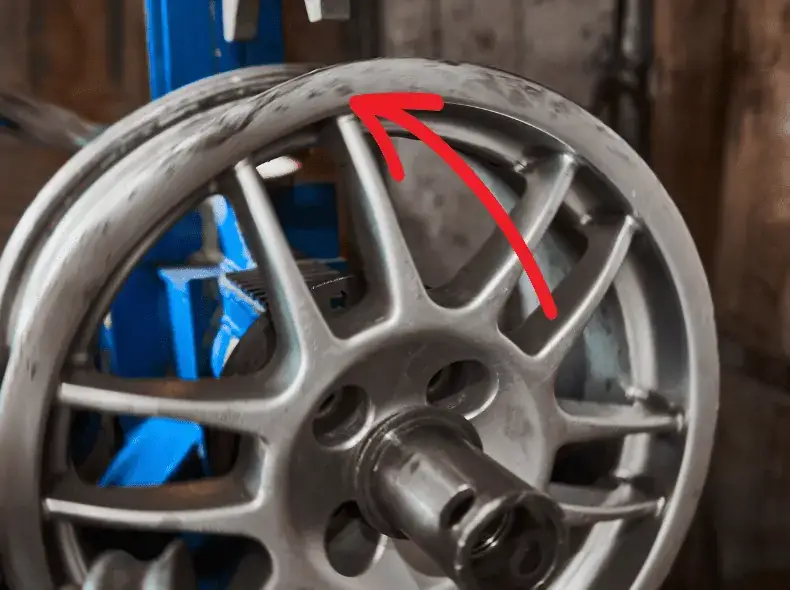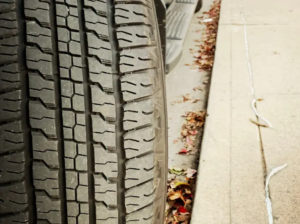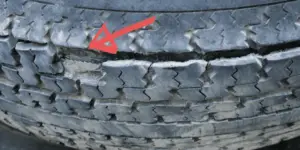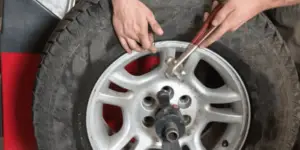If you have a bent rim, it can cause vibration.
All bent rims are different, but even if it isn’t causing vibration right now, any additional damage or impact from driving over a pothole could be the difference between a bent rim not vibrating and starting to.
Unfortunately, it’s not always obvious how badly a rim is bent. What you see at the front may not be replicated at the back or where the tire is seated.
Can A Bent Rim Vibrate And Shake When Steering?
Absolutely.
A bent rim is usually the result of hitting a curb or pothole. When this happens, the rim can become out of round, and this sensation passes up through the steering column and steering wheel. This is especially true if a front rim is bent.
This can be especially problematic if you have an older car. A bent rim will strain ball joints, CV Joints, struts, and shocks.
Older cars that have not had these replaced recently are more likely not to be able to cope with a bent rim, and therefore, the vibration in a steering wheel may be more pronounced in older vehicles than in newer ones.
Other Bent Rim Symptoms
Your Car Handling Feels Off
It’s not just vibration that may occur if you have a bent rim. The delicate wheel alignment may have been affected.
You can check for this by briefly taking your hands off the steering wheel while driving straight.
If the car wanders to one side or another, this is a sure sign your wheel alignment is now bad and needs to be fixed.
There Is Hidden Damage To Your Rim
It’s always worth getting underneath your car and checking the back of the rim to see if any more damage has been done.
Although the impact may be at the front, the impact’s force can quite often damage the rear of the rim as well.
Any damage to the rim will mean that the tire needs to be rebalanced.
Do you see cleaner rectangle areas close to the tire bead on the rim? If so, it’s likely a weight was knocked off the rim during the impact, causing the vibration.
A tire rebalancing is cheaper than a rim repair. So if the rim damage is minor, you might get away with a rebalance in the short term.

Your Tire Keeps Are Leaking
As your tires and rims are perfectly circular, any bend in the rim will mean that the tire bead can no longer sit correctly underneath the rim lip.
High air pressure will always try to mix with lower pressure. Standard air pressure is 14 PSI, and your tire pressure may be 35 PSI.
If the seal on your rim and tire is broken, the high air pressure within your tire will leak out into the atmosphere.
Always spend time thoroughly inspecting the tire on a bent rim. There is a good chance the damage has been caused to it on impact as well. Pay particular attention to any bulges or tears in the sidewall. These could make the tire to be out of round and cause vibration.
Many tire blowouts are caused by structural defects in the sidewall caused by impacts. Usually, the blowout occurs at the same time as the impacts but not always.
Sometimes reinflating a weakened tire on a damaged rim will blow out the next time you drive over a pothole or hit a curb.
Braking Feels Less Responsive
Another symptom of a bent rim is braking feels different. If the rim is bent, your caliper – which holds the pads- or the rotor may also have been damaged on the impact.

Any misalignment by a couple of mm can be the difference between the pads contacting the rotor as intended when you brake and not. You may also experience noise from the area of the bent rim when driving. This could be the brake pad catching on the rotor as the rim rotates.
Bent Rims and Wheel Bearings
The rim is connected to the axle by way of wheel bearings. These bearings are encased in grease, allowing the wheel to turn without friction.
The wheel bearing assembly may be damaged by the impact on the rim. There may not be any immediate sign that the bearings are damaged but having a vibrating bent rim connected to it over the long term will stop it from turning as smoothly as it should.
Added strain can cause the bearings to wear sooner than they would.
Can I Still Drive If I Have a Bent Rim?
It is a risk that only you can make a decision over. Ideally, you shouldn’t drive until the rim is inspected, repaired, or replaced.
If you have a spare steel wheel or rim in the trunk, swap over to that in the short term.
Driving on a bent rim could risk tire blowouts and earlier failure of suspension parts, wheel bearings, and brake rotors and pads.
It’s almost impossible to know the full extent of the damage until the tire is removed.
Is it Possible to Repair a Bent Rim?
Bent rims can be repaired most of the time. This is not something you can do at home in your garage. It will require a visit to a proper tire or rim specialist.
Some people will say they have repaired their rims. Usually, this means they have used a tire iron to lift off part of the lip section that has been pushed in by a curb.
This is not really a bent rim, and even so, it’s very unlikely it will be circular using this crude method.
An expert repair involves mounting the tire on a specialist straightening machine, heating the alloy, or using cold roller technology to make it pliable and able to be reworked.
A specialist will also check for cracks and other defects before repairing so you know 100% that your room is safe to be put back on your vehicle.
In Conclusion
A bent rim can cause vibration. Front rims will often cause vibrations to travel up to the steering wheel and cause the steering wheel to shake.
Other problems arising from bent rim can include leaking tires, brake noise even when the brakes aren’t applied and poor wheel alignment.













